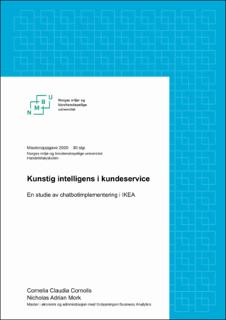| dc.contributor.advisor | Alfnes, Frode | |
| dc.contributor.author | Cornolis, Cornelia Claudia | |
| dc.contributor.author | Mork, Nicholas Adrian | |
| dc.date.accessioned | 2020-10-07T13:31:21Z | |
| dc.date.available | 2020-10-07T13:31:21Z | |
| dc.date.issued | 2020 | |
| dc.identifier.uri | https://hdl.handle.net/11250/2681621 | |
| dc.description.abstract | Denne masteroppgaven er en casestudie som følger IKEA gjennom et pilotprosjekt om implementering av chatbot i kundeservice våren 2020. Studien deles inn i tre stadier, hvor første stadiet handler om identifisering av behovet for en chatbot i IKEA. Det andre stadiet handler om konstruksjon av chatboten og redegjør for hvilke muligheter og begrensninger som eksisterer i IKEA for implementering. Etter-stadiet fokuserer på de initiale effektene av chatboten etter implementering, samt hvilke faktorer som bidrar til at kunder av IKEA benytter chatboten.
Hele implementeringsprosessen redegjøres på bakgrunn av både kvalitativt og kvantitativt datagrunnlag, som består av intervjuer med IKEA og de involverte partene Boost Ai og NetNordic. For å få bredere innsikt omkring chatbot og andre bransjer, ble også Kantar intervjuet. En forskningsmodell ble også utarbeidet på grunnlag av en spørreundersøkelse rettet mot kunder av IKEA.
Resultatet fra første stadiet viser at endrede kundeforventninger, økt kontaktvolum og kompetanseheving viser behovet av en chatbot i IKEAs kundeservice. Resultatene i det andre stadiet viser at en chatbot har mulighet til å besvare henvendelser som relateres til FAQ og ordresporing. IKEA har også mulighet til å sette sammen en prosjektgruppe bestående av ulik kompetanse og erfaringer fra ulike områder. IKEA har begrensninger knyttet til dårlig koordinasjon med den globaliserte IT-avdelingen, eldre IT-systemer og mangler på APIer. Siste stadiet viser at chatboten har en begrenset effekt i reduksjon av kontaktvolumet fordi mange av kundehenvendelsene faller utenfor dens område. Det eksisterer likevel positive effekter ved at chatboten skaper verdi for de kundehenvendelsene som predikeres riktig, samt at den predikerer store mengder med kundehenvendelser samtidig. I tillegg opererer den døgnkontinuerlig. Skalerbarheten i chatboten gjør at den tilpasser seg endrede omgivelser relativt fort. Resultatene fra forskningsmodellen viser at løsningsgraden til chatboten må være høy, operere brukervennlig og fascinere for at kunder av IKEA vil bruke chatboten.
Vår masteroppgave viser at detaljhandel er preget av komplekse vare- og tjenesteporteføljer, som skaper utfordringer for en begrenset kognitiv chatbot i kundeservice. Dette tyder på at kunstig intelligens har en vei å gå før den ønskede merverdien blir oppfylt. | en_US |
| dc.description.abstract | This master’s thesis is a case study that seeks to analyze the implementation process of a chatbot in IKEA’s customer service. The thesis follows IKEA through a pilot project during the spring of 2020. The first stage involves the identification of the need of a chatbot in IKEA’s customer service. The second stage involves the construction of the chatbot and clarifies the possibilities and limitations that exist in IKEA in relation to the implementation. The after stage focuses on the initial effects after the implementation and what factors contribute to customers of IKEA using the chatbot.
The implementation process is explained on the basis of both qualitative and quantitative data, which consist of interviews with IKEA, Boost Ai and NetNordic. In order to gain a broader understanding of chatbot and other industries, we also interviewed Kantar. A research model was also developed based on a survey aimed at customers of IKEA.
Our results in the first stage show that changes in customers’ expectations, an increase in contact volume and competence development indicates to a need for a chatbot in IKEA’s customer service. The second stage shows that the chatbot has the possibility to answer inquiries related to FAQ and order tracking. IKEA also has the possibility to assemble a project team, consisting of mixed competence and experience. IKEA has limitations related to poor coordination with it’s global IT-department, older IT-systems and lack of relevant APIs. The results of the after stage show that the chatbot creates a limited effect in reducing the contact volume because many of the customer inquiries fall outside of the chatbot’s limited domain. However, there are some positive effects related to correctly predicted inquiries, and the possibility to frequently predict customer inquiries at the same time. In addition, the chatbot operates 24 hours a day. The scalability of the chatbot allows it to quickly adapt to changing surroundings. The results of the research model show that performance expectancy, effort expectancy and hedonic motivation are important factors that explain the customers’ behavioral intention to use the IKEA chatbot.
Our master’s thesis shows that the retail industry is characterized by complex product and service portfolios, which create challenges for a limited cognitive chatbot in customer service. This implies that artificial intelligence still has a long way to go before a chatbot is viable in the retail industry. | en_US |
| dc.language.iso | nob | en_US |
| dc.publisher | Norwegian University of Life Sciences, Ås | en_US |
| dc.rights | Attribution-NonCommercial-NoDerivatives 4.0 Internasjonal | * |
| dc.rights.uri | http://creativecommons.org/licenses/by-nc-nd/4.0/deed.no | * |
| dc.subject | Maskinlæring | en_US |
| dc.subject | Chatbot | en_US |
| dc.subject | Kunstig intelligens | en_US |
| dc.subject | Detaljhandel | en_US |
| dc.title | Kunstig intelligens i kundeservice : en studie av chatbotimplementering i IKEA | en_US |
| dc.title.alternative | Artificial intelligence in customer service : a study of chatbot implementation in IKEA | en_US |
| dc.type | Master thesis | en_US |
| dc.source.pagenumber | 120 | en_US |
| dc.description.localcode | M-ØA | en_US |

